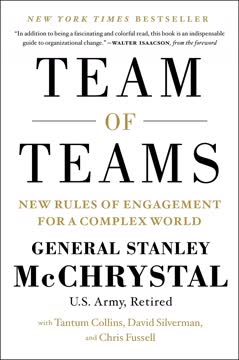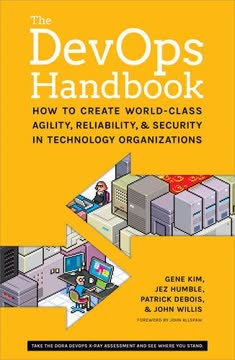Key Takeaways
1. Agile IT organization design prioritizes value over predictability
Software development is a design process rather than a production process.
Rethinking software development. Traditional IT organizations often treat software development as a predictable production process, leading to unrealistic expectations and failed projects. By recognizing software development as a design process, organizations can shift their focus from rigid plans to delivering value iteratively.
Embracing uncertainty. Agile IT design acknowledges that unknown unknowns are inherent in software development. Instead of attempting to eliminate uncertainty through extensive upfront planning, Agile approaches:
- Encourage rapid prototyping and frequent feedback
- Prioritize working software over comprehensive documentation
- Allow for course corrections based on new information
- Focus on delivering tangible business value in short iterations
This shift in mindset enables organizations to respond more effectively to changing market conditions and customer needs, ultimately leading to better outcomes and increased business agility.
2. Cross-functional teams drive responsiveness and innovation
Collaboration within teams tends to be unscripted—on demand, just in time, and continuous.
Breaking down silos. Traditional IT organizations often structure themselves around functional specialties (e.g., development, testing, operations), creating silos that hinder collaboration and slow down delivery. Cross-functional teams bring together diverse skills and perspectives, enabling:
- Faster decision-making and problem-solving
- Reduced handoffs and communication overhead
- Increased ownership and accountability for outcomes
Fostering innovation. By combining different expertise and viewpoints, cross-functional teams create an environment ripe for innovation:
- Team members learn from each other, broadening their skill sets
- Diverse perspectives lead to more creative solutions
- Rapid prototyping and experimentation become easier to implement
Organizations can structure cross-functional teams around products, services, or business capabilities to align more closely with business outcomes and improve overall agility.
3. Outcome-oriented structures foster autonomy and purpose
To be accountable for an outcome, we need authority for making decisions, not just responsibility for execution.
Aligning with business goals. Organizing IT around business outcomes rather than activities creates a stronger connection between IT efforts and business value. This approach:
- Provides teams with a clear sense of purpose
- Encourages end-to-end ownership of solutions
- Facilitates better prioritization of work based on business impact
Empowering teams. Outcome-oriented structures give teams the autonomy to make decisions and choose the best approaches to achieve their goals:
- Reduces micromanagement and bureaucracy
- Increases job satisfaction and intrinsic motivation
- Enables faster response to changing conditions
To implement outcome-oriented structures effectively, organizations must:
- Clearly define and communicate desired outcomes
- Provide teams with necessary resources and authority
- Hold teams accountable for results, not just activities
- Foster a culture of trust and continuous learning
4. Continuous delivery and DevOps are integral to Agile IT
Continuous delivery is integral to Agile software delivery just as continuous integration is integral to Agile software development.
Streamlining the delivery pipeline. Continuous delivery (CD) and DevOps practices aim to reduce the time and risk associated with releasing software changes:
- Automate build, test, and deployment processes
- Enable frequent, small releases instead of large, infrequent ones
- Improve collaboration between development and operations teams
Benefits of CD and DevOps:
- Faster time-to-market for new features and fixes
- Reduced risk through smaller, more manageable changes
- Improved quality through consistent, repeatable processes
- Increased feedback and learning opportunities
Implementing CD and DevOps requires both technical and cultural changes:
- Invest in automation tools and infrastructure
- Foster a culture of shared responsibility between dev and ops
- Emphasize continuous improvement and learning
- Align incentives around successful outcomes, not just individual activities
5. Intrinsic motivation trumps extrinsic rewards in knowledge work
Autonomy, mastery, and purpose are intrinsic motivators. They work better than traditional extrinsic motivators do.
Understanding motivation in IT. Knowledge work, such as software development, thrives on intrinsic motivation rather than external rewards or punishments. Organizations can foster intrinsic motivation by focusing on:
- Autonomy: Giving teams control over how they achieve outcomes
- Mastery: Providing opportunities for skill development and growth
- Purpose: Connecting work to meaningful business and customer impact
Rethinking rewards and incentives. Traditional extrinsic motivators like bonuses or promotions based on individual performance metrics can often lead to unintended consequences:
- Encourage short-term thinking and local optimization
- Reduce collaboration and knowledge sharing
- Diminish creativity and risk-taking
Instead, organizations should:
- Emphasize team-based rewards aligned with business outcomes
- Create a culture of continuous learning and improvement
- Provide regular feedback and recognition for valuable contributions
- Offer opportunities for career growth and skill development
6. Metrics should inform, not control, in Agile environments
When a measure becomes a target, it ceases to be a good measure.
Beyond measurement. While metrics are essential for understanding progress and identifying areas for improvement, overreliance on metrics can lead to dysfunctional behaviors:
- Gaming the system to meet targets
- Focus on local optimization at the expense of overall outcomes
- Reduced innovation and risk-taking
Informative vs. motivational metrics. Agile organizations should use metrics primarily to inform decision-making rather than to control behavior:
- Focus on outcome-oriented metrics rather than activity-based ones
- Use metrics as a starting point for conversations, not as definitive judgments
- Regularly review and adjust metrics to ensure they remain relevant
Effective use of metrics in Agile environments:
- Emphasize leading indicators that provide early feedback
- Use a balanced set of metrics to capture different aspects of performance
- Encourage teams to define their own metrics aligned with business outcomes
- Foster a culture of transparency and continuous improvement around metrics
7. Open communication and collaboration are essential for agility
Organizational agility needs a culture of unscripted collaboration.
Breaking down barriers. Agile organizations thrive on open, transparent communication and collaboration across all levels:
- Encourage face-to-face interactions and informal communications
- Reduce hierarchical barriers to information flow
- Promote cross-functional and cross-team collaboration
Tools and practices for open communication:
- Information radiators: Visual displays of important information
- Open-plan office layouts that facilitate spontaneous interactions
- Digital collaboration tools that enable remote and asynchronous work
- Regular all-hands meetings and town halls for company-wide updates
Fostering psychological safety. To enable truly open communication, organizations must create an environment where:
- People feel safe to express ideas and concerns without fear of retribution
- Failure is seen as an opportunity for learning, not punishment
- Diverse perspectives are valued and actively sought out
- Constructive conflict and healthy debate are encouraged
8. Physical and virtual workspace design impacts organizational agility
Open-plan layouts encourage collaboration and deemphasize hierarchy.
Rethinking office space. The physical environment plays a crucial role in shaping collaboration and communication patterns:
- Open-plan layouts facilitate spontaneous interactions and knowledge sharing
- Flexible spaces accommodate different work styles and team needs
- Dedicated areas for quiet work and focused concentration balance collaboration
Virtual workspace considerations. With the rise of remote work, organizations must also design effective virtual environments:
- Invest in reliable, user-friendly communication and collaboration tools
- Establish clear norms for virtual meetings and asynchronous communication
- Create opportunities for informal virtual interactions to maintain team cohesion
Balancing physical and virtual workspaces:
- Hybrid work models that combine in-office and remote work
- Equip meeting rooms for effective hybrid collaboration
- Design physical spaces that complement and enhance virtual collaboration
9. Agile budgeting focuses on capacity funding over project-based allocation
Budget for capacity, not for projects.
Rethinking IT funding. Traditional project-based budgeting often leads to short-term thinking and artificial constraints on IT work. Capacity-based funding aligns better with Agile principles:
- Fund stable, long-lived teams rather than temporary project teams
- Allocate budget based on business priorities and outcomes
- Allow for more flexible allocation of resources as priorities change
Benefits of capacity-based funding:
- Reduces administrative overhead of project-based accounting
- Encourages long-term thinking and investment in capabilities
- Enables faster pivots and reprioritization of work
- Aligns incentives around delivering business value, not just completing projects
Implementing capacity-based funding requires changes to:
- Financial processes and reporting
- Portfolio management practices
- Performance measurement and accountability systems
10. Agile transformation requires cultural shift beyond IT practices
Culture change is mostly a by-product of changes in leadership, behavior, org structure, policies, and operational practices.
Holistic transformation. Successful Agile adoption requires changes beyond just IT practices and processes:
- Leadership styles that emphasize empowerment and servant leadership
- Organizational structures that support cross-functional collaboration
- Policies and procedures that enable rapid decision-making and experimentation
- Operational practices that prioritize value delivery and customer feedback
Cultural elements of Agile transformation:
- Embracing uncertainty and learning from failure
- Fostering a growth mindset and continuous improvement
- Emphasizing transparency and open communication
- Valuing diversity of thought and collaborative problem-solving
Overcoming resistance to change:
- Communicate the "why" behind the transformation
- Provide training and support for new ways of working
- Celebrate and share early successes to build momentum
- Address legacy systems and processes that hinder agility
- Align incentives and performance metrics with desired behaviors
Last updated:
Review Summary
Agile IT Organization Design receives mixed reviews. Many praise its comprehensive coverage of agile principles and organizational design, finding it insightful for IT professionals and leaders. Readers appreciate the practical examples and ideas for improving agility. However, some criticize the book for being too broad and lacking depth in certain areas. Critics also note that it can be difficult to read and may not offer much new information for experienced agile practitioners. Overall, it's recommended for those interested in organizational agility, especially in IT contexts.
Similar Books
Download PDF
Download EPUB
.epub digital book format is ideal for reading ebooks on phones, tablets, and e-readers.







